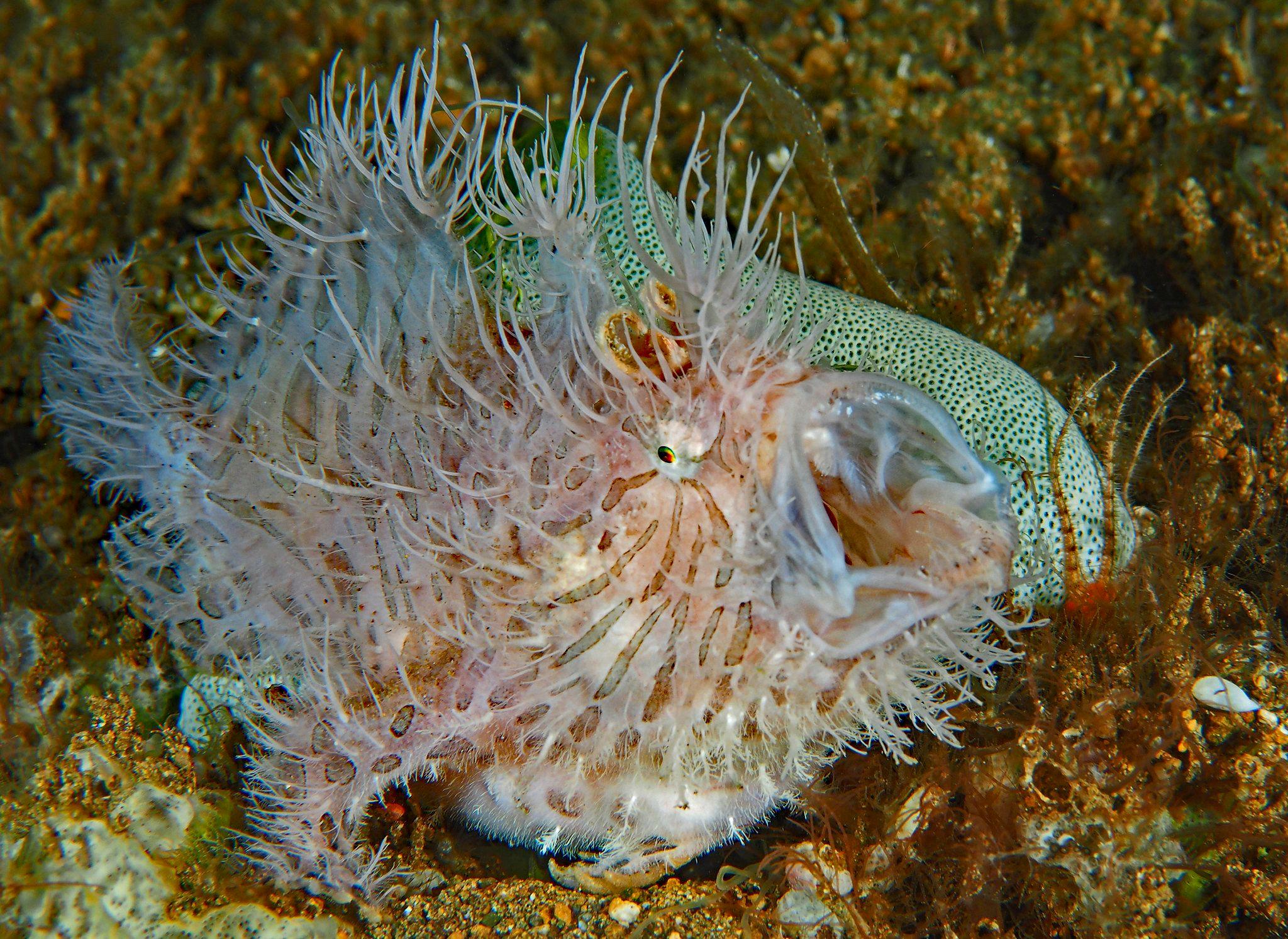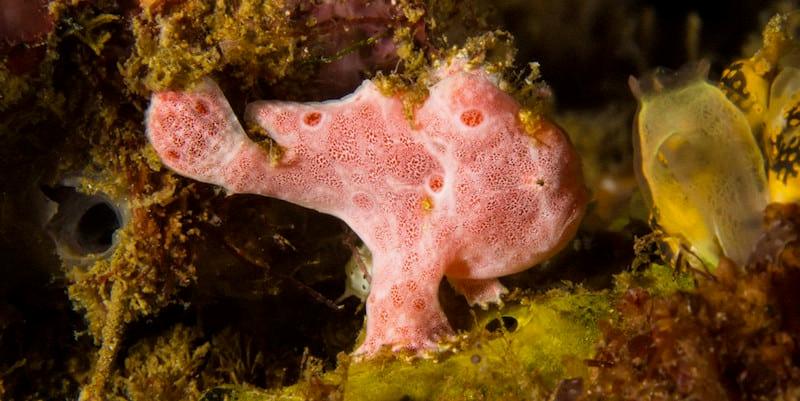Frogfish are an incredibly unique and fascinating species of fish that are found in the ocean’s reef environments. Also known as anglerfish, these peculiar creatures have some incredible physical characteristics and habits that make them stand out from other fish.
Firstly, let’s start with their physical appearance. Frogfish have a unique body shape with large pectoral fins which have an “elbow-like” bend at the front and then just behind these they have smaller pelvic fins which resemble legs. This is common across all frogfish species and it is from this resemblance to frogs that they take their name. Frogfish come in a variety of colors ranging from bright yellow to white, black or even red. Many species also feature markings such as spots or stripes which help them blend into the coral in their environment.
Frogfish are also known for their ability to “walk” on the sea floor by using their pectoral fins to move around without swimming. This allows them to sneak up on potential prey without being noticed and gives them a huge advantage in the hunt for food! As well as walking, frogfish also possess remarkable camouflage abilities; they can change color according to their surroundings and even mimic other animals such as sea anemones in order to attract prey closer and then snatch it up with lightning speed!
In terms of diet, frogfish mainly feed on small invertebrates such as shrimp, crabs and worms but they have been known to eat small fish too if necessary. Thankfully, despite their rater intimidating appearance, frogfish are not poisonous and should not be eaten (not that you would want too!).
Overall, frogfish are one of the most interesting species of ocean dwellers out there due to their unusual behavior, physical appearance and ability to adapt so perfectly within their environment. If you ever get a chance, be sure to check them out!
Are Frogfish Poisonous?
No, the majority of frogfish are not poisonous. Frogfish are a type of anglerfish, in the family Antennariidae, and most species are not known to be toxic or venomous. The only known poisonous frogfish is the toadfish, which belongs to the family Batrachoididae. However, it should be noted that even though these fish are not considered poisonous, they are definitely not considered edible either – so you shouldn’t eat them even if you come across them!
Keeping a Frogfish as a Pet
Yes, a frogfish can make an interesting and rewarding pet for an experienced aquarist. Frogfish can be found in tropical and subtropical waters aroud the world, so you should be able to find a species suitable for your tank. They are relatively easy to care for, but they do have some unique needs that must be met.
Frogfish require tanks of at least 30 gallons with plenty of hiding places and live rocks. They need to be fed a variety of live, frozen, or freeze-dried food such as small fish, shrimp, worms, or crustaceans. They also do best in temperatures between 72°F and 78°F and thrive in water with a salinity of 1.023-1.025 specific gravity. It is important to monitor the water quality closely as frogfish are sensitive to changes in their environment.
If you’re looking for an interesting addition to your aquarium, then a frogfish may be the perfect choice!
Are Frogfish Frogs or Fish?
No, a frogfish is not a frog; it is a fish. A frogfish belongs to the Actinopterygii order, which makes it a ray-finned fish, and it is part of the Antennariidae family. Frogfish can be found in reefs, and the Sargassum fish lives in the Sargasso Sea. Unlike frogs, these fish have elongated bodies with flat heads and large mouths. They also have spines on their heads that act like antennae to help them detect prey.
What Makes a Frogfish Unique?
A frogfish is called a frogfish due to its similarities in appearance to frogs. Unlike most other fishes, frogfishes have unique pectoral fins which have an “elbow-like” bend at the front, and just behind these they have smaller pelvic fins which resemble legs. This feature is common across all species of frogfish, making them distinct and easy to identify among other fish. The combination of their elbowed pectoral fins and their legs-like pelvic fins give them a strong resemblance to frogs, hence why they are called ‘frogfishes’.
The Eating Speed of a Frog Fish
The frogfish is an incredibly fast eater, with some species able to swallow prey in as little as 6 milliseconds! This rapid feeding is made possible by the frogfish’s remarkable mouth cavity, which can expand and contract to up to 12 times its size. This allows it to instantaneously engulf even larger fish that have been fooled by its remarkable camouflage. With this powerful suction, it can create a vacuum within its mouth that sucks in the prey like a dustpan. So, when you see one of these predators lurking in the water, be sure to give it a wide berth!

Source: pinterest.com
Can Frogfish Move On Land?
Yes, frogfish are capable of walking on land. They have an unusual locomotion method which involves using their pectoral fins to ‘walk’ in a jerky motion. This allows them to move around on land and even climb up rocks or other structures. In the water, they use the same technique but with more grace, gliding along the sea floor. This form of locomotion helps them to hide from predators and find food.
Feeding Requirements for Frog Fish
Frogfish are opportunistic feeders and will generally accept all kinds of meaty food items. It is best to offer a variety of live, frozen, and freeze-dried foods. Offer live foods such as small shrimps, mysis shrimp, brine shrimp, krill, silversides, etc., as well as defrosted frozen whitebait dangled on tongs. Freeze-dried or frozen food like bloodworms and tubifex can also be offered. Occasional treats such as pieces of squid or mussel can also be given. Avoid feeding them too much live fish, as this can cause them to become aggressive towads each other. It is important to keep the frogfish well fed in order to prevent one from swallowing its partner!
Are Anglerfish and Frogfish the Same?
No, anglerfish and frogfish are not the same. Anglerfish belong to the family Antennariidae, while frogfish belong to the family Batrachoididae. Both families are part of the order Lophiiformes.
Anglerfish are found in tropical and temperate waters around the world and are known for their characteristic lure or “fishing pole” appendage on their heads that they use to attract prey. They also have large mouths and a body covered with spines. Frogfish, on the other hand, are found in shallow waters of the Atlantic, Pacific, and Indian Oceans. They have short spines along their bodies but do not have a lure like anglerfish. They usualy have a more oval-shaped body compared to anglerfish, which tend to be more elongated.
Are Frogfish Found in Hawaii?
Yes, frogfish are found in Hawai’i. They are typically found in quiet areas of the coral reef and occasionally on shallow reef flats. There is estimated to be about ten species of frogfish that inhabit the Hawaiian Islands with the largest being the Commerson’s frogfish (Antennarius commerson) which can reach up to one foot in length. These fish have adapted well to their environment and can be seen camouflaged amongst the coral reefs in search of small prey.
The Speed of a Frogfish Strike
The hairy frogfish is capable of striking its prey in an unbelievable 1/6000th of a second. This lightning-fast vacuum-like strike is made possible by the frogfish’s unique anatomy. When it senses potential prey, its mouth balloons to up to 12 times its original size and creates a powerful suction that sucks in whatever is nearby. This process happens so quickly that it appears instantaneous to the human eye. Scientists have clocked the speed of this strike at an impressive 590 mph, making it one of the fastest predatory moves in the animal kingdom.

Source: twofishdivers.com
Maximum Size of a Frogfish
Frogfishes are usually quite small, with the largest species reaching a maximum length of about 30 cm (12 inches). Most species are much smaller, growing to around 10-15 cm (4-6 inches) in length. Frogfishes have robust bodies and large mouths, and some species have spines or prickles on their skin.
Can Frogfish Live in Freshwater?
Yes, frogfish can live in freshwater. They are a member of the family Antennariidae, which encompasses both marine and freshwater species. The only known member of this family that is capable of venturing into brackish to pure freshwater conditions is the ‘freshwater’ frogfish (Antennarius striatus). It is most commonly found in estuarine or brackish waters, but it has been found in pure freshwater environments such as rivers and swamps.
These fish have adapted to their environment by developing a thick slime coat that helps them survive in the low-salinity environment. In the wild, they are ambush predators that feed on small crustaceans and other invertebrates. In captivity, they should be fed a variety of meaty foods such as krill, shrimp, and worms.
Freshwater frogfish are not commonly seen in the hobby because they are hard to find and can be difficult to keep alive due to their unique needs. They require warm temperatures (above 75°F) and should be kept in an aquarium with plnty of hiding places so they can ambush prey. They also require high oxygen levels (above 7 ppm) and regular water changes to stay healthy.
Conclusion
In conclusion, frogfish are fascinating and unique creatures. They are a ray-finned fish in the Actinopterygii order, and the majority of them are not poisonous. Frogfish live in reefs, but some species like the Sargassum fish can live amongst seaweed. Frogfish take their name from the fact that they have unique pectoral fins which have an “elbow-like” bend at the front and then just behind tese they have smaller pelvic fins which resemble legs. Therefore, if you want to keep one as a pet, it is important to give them the right environment and care so that they can thrive in captivity.












